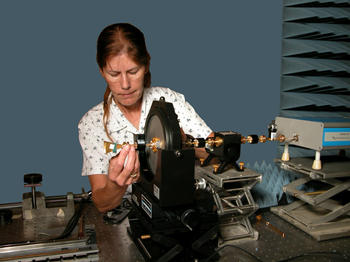Summary
Antennas are the eyes, ears and voice boxes of everything from cell phones to interplanetary spacecraft. The Antenna Metrology Program carries on NIST's pioneering work on testing high-end antennas for critical hardware such as communications satellites, scientific spacecraft, radar and aircraft. The program focuses on improving its near-field scanning technique, which transforms measurements taken at distances of a few centimeters into accurate predictions of an antenna's performance at distances of millions of kilometers. Using mathematical algorithms developed at NIST, the technique works for antennas operating at frequencies as high as 110 gigahertz and is used at hundreds of test ranges worldwide. Recent advances promise to extend the method's capability to still higher frequencies.
Description

The NIST millimeter-wave extrapolation range being prepared for antenna measurements.
NIST CTL’s Antenna Metrology Project combines theoretical models, analytical tools, and custom-developed facilities to advance the field of antenna measurement and share those advances with industry, government, and academic users. Two generations ago, NIST pioneered the near-field scanning techniques now central to antenna characterization, and have since applied the approach to antennas on systems ranging from military radar to interplanetary spacecraft.
Today, we’re combining our state-of-the-art Antenna and Communication Metrology Laboratory (ACML), our Configurable Robotic MilliMeter-wave Antenna facility (CROMMA), and other toolsets to support the development of high speed, dynamic antenna systems operating in motion and across frequencies ranging from 1 gigahertz to 1 terahertz. These systems will be vital to next-generation 5G wireless systems tasked to keep up with skyrocketing demand for wireless data.
Technical Goals
• Extending near-field metrology into the millimeter-wave range from 50 GHz up to 500 GHz.
• Characterizing and measuring active, dynamic antennas such as MIMO, massive MIMO, and steerable phased-array antennas.
• Improving and advancing existing near-field theoretical, analytical, and numerical approaches to take into account parameters unique to the modeling of modern antennas and communication systems.
The CTL’s Antenna Metrology Project focuses on the following major activities:
The Antenna Communication and Metrology Laboratory (ACML)
The ACML, scheduled for completion in 2016, will develop metrology for advanced antenna systems operating in complex electromagnetic environments. Its capabilities, based around two six-axis industrial robot arms modeled on our lab’s pioneering CROMMA system, will foster the development of next-generation 5G wireless and spectrum sharing systems through precision alignment, dynamic measurements, flexible scan geometries, and high speeds. Between the new, dual-robot range and CROMMA, which is also a part of the ACML, the Antenna Metrology Project will be able to test and characterize multiple steered-beam and other antennas from just below 1 gigahertz up to as high as 500 gigahertz.
Near-field scanning metrology advancement
This work focuses on extending NIST-developed near-field scanning techniques to the millimeter wavelengths and dynamic systems made possible by the new ACML facility. Extremely accurate position and pointing data acquired via the ACML laser tracker system will allow correction techniques to be added to near-field data processing algorithms. Smart, active antennas and massive MIMO systems will require new near-field scanning approaches to capture their multi-beam, dynamic characteristics. New performance metrics that capture the antenna contribution to communications signal quality and channel capacity in support of next-generation 5G wireless systems need to be developed. Uncertainties analyses need to be developed for highly modulated, highly correlated multi-channel antenna systems.
Antenna theory and channel modeling
Well-characterized antennas will be the heart of communications systems across wide range of frequencies. The ACML will be used to investigate propagation effects for next generation wireless systems. We’re developing new frameworks to model moving beams, Doppler shifts in cases where multiple antennas are moving, the effect of dynamic use cases on digitally formed signals, and free-space propagation of modulated signals for sing-input, single-input, single-output (SISO) and MIMO cases. This work will feed into CTL channel modeling efforts, particular in cases of multi-frequency or wide-channel measurements.
Other activities to support government organizations
We work the Department of Homeland Security, the Department of Energy, the Department of Defense and other federal entities on antenna testing and free-field scattering measurements.
Major Accomplishments
2015
Standard gain horn spherical scan pattern measurements at 183 GHz
Standard gain horn spherical scan pattern measurements at 118 GHz
Standard gain horn extrapolation gain measurements at 118 GHz
Pixel probe development and corrected scan accuracy improved to < 20 microns
2014
CROMMA completed and brought online with integrated dynamic laser tracker and Tmac
Uncorrected scan accuracy shown to be better than 100 microns
• M. Francis, R. Wittmann, “Near-Field Scanning Measurements: Theory and Practice,” in Modern Antenna Handbook, John Wiley, Ch. 19, pp. 929-976, 2008.
• R. Wittmann, M. Francis, R. Direen, “Chamber Imaging Using Near-Field Scanning,” in Proc. 2008 IEEE Antennas and Propagation Symposium (San Diego, CA), ID 10.1109/APS.2008.4619141, July 2008.
• J. Guerrieri, K. MacReynolds, M. Francis, R. Wittmann, D. Tamura, “Planar Near-Field Measurement Results Up To 94 GHz Using Probe Position Correction,” in Proc. 27th AMTA Symposium (Newport, RI), pp. 110-116, October 2005.

